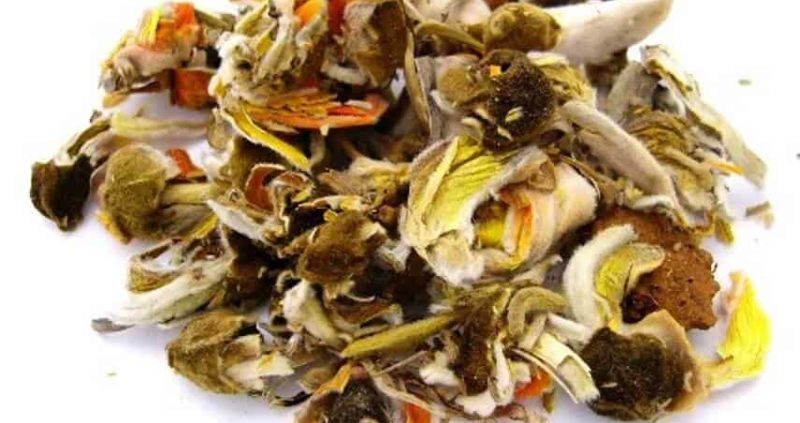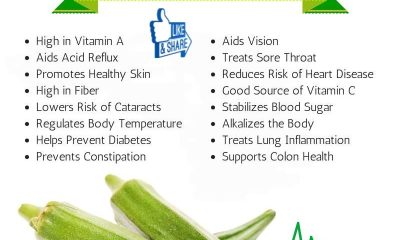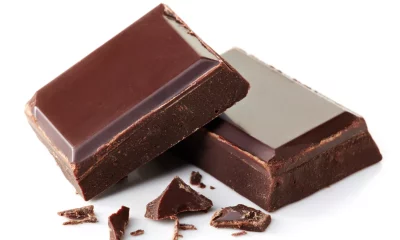Health
11 best foods to lower bad cholesterol (LDL)

Discover the best 11 foods to lower bad cholesterol (LDL).
Foods and ingredients that, incorporated into the diet, help us fight bad cholesterol.
Cholesterol is a molecule composed of fatty acids that, when found in excessive levels in the blood, can cause heart disease, which is why there is a general concern to lower cholesterol levels.
Exercise, maintaining a healthy weight, not smoking, and adding foods to lower bad cholesterol to the diet are the recommendations that doctors make to counteract this evil.
10 foods that help lower bad cholesterol
For cholesterol to be transported through the blood, it needs lipoproteins; When these are of low density and their levels are excessive, they accumulate in the circulatory system, blocking it, the so-called “bad cholesterol” appears.
On the other hand, if the lipoproteins are of high density, they transport the cholesterol that accumulates in the circulatory system and helps to eliminate it, it is the “good cholesterol”
What foods help lower bad cholesterol levels? Let’s see a few.
1. Oatmeal
It is the food par excellence in the mission of lowering bad cholesterol levels. It contains a fiber that, unlike other cereals, is soluble.
It is recommended to consume three grams of oats daily, and when cholesterol levels are not very high, in a few weeks they will drop considerably.
2. Apple
Eating an apple a day takes care of the arteries, as it reduces the absorption of the fact that other foods provide.
This fruit to a certain extent prevents cholesterol from adhering to the wall of the blood vessels thanks to the fact that it contains flavonoids.
It will also help you fight hypertension and not retain fluids. In short, regularly consuming apples is excellent for lowering blood cholesterol levels.
3. Flax and Chia Seeds
These seeds are a good source of omega 3 and studies show that their consumption reduces cholesterol between 6 and 13%. Chia seeds are also very rich in fiber and antioxidants.
They can be included in salads as the recommendation is that they be consumed without soaking.
4. Egg white
Contrary to the belief that eggs raise blood cholesterol levels, the fatty acids in egg whites help increase good cholesterol. Having two boiled egg whites for breakfast is one of the best food alternatives to lower bad cholesterol.
5. Vegetable oils
Sunflower, olive, or canola oil should substitute for oils of animal origin. These vegetable oils contain polyunsaturated fatty acids.
Accompanying salads or vegetables and fruits with these oils that help lower cholesterol levels is an excellent option.
6. Eggplant
Eggplant is a fruit that contains chlorogenic acid that helps prevent good cholesterol from oxidizing. It also works by absorbing cholesterol in the blood. It should be eaten cooked and whole without removing the skin or the seeds.
Eggplant is a powerful food to lower cholesterol levels; just cut it into large pieces, cook it and consume it to notice results in a short time.
7. Walnuts
Walnuts contain a type of omega 3 that not only increases good cholesterol and reduces bad cholesterol, but also promotes the elasticity of blood vessels, prevents blood clots, and lowers high blood pressure.
It is enough to consume 3 or 4 a day for this seed to lower cholesterol levels. But you should not eat too many, as they contain a lot of fat.
8. Legumes
These are effective foods to lower bad cholesterol because they are a source of soluble fiber that works like a broom, sweeping it away and then eliminating it along with the feces.
But it is not the only function of legumes. When fiber is working, the liver needs more cholesterol to produce more bile salts, thus reducing its concentration.
Lentils, beans, chickpeas, and beans should be consumed regularly to reduce bad cholesterol in the body.
9. Blueberries
These berries increase good cholesterol and reduce blood pressure, artery stiffness, and general inflammation. In general, they are considered an excellent food to take care of the heart and their consumption is excellent for lowering good cholesterol.
Blueberries can be consumed dried or fresh and in either form is food that lowers cholesterol levels.
10. Fatty fish
Faced with a high level of cholesterol in the blood, we must eliminate the consumption of red meat. A good substitute for these is fish such as mackerel, salmon, tuna, sardine, or trout. They can be cooked on the grill.
These foods are rich in omega 3, so they lower blood pressure, prevent blood clotting, and therefore lower total cholesterol.
11. Almonds and chocolate
The surprise on the list of foods that lower bad cholesterol is chocolate. The truth is that the exact combination of almonds and chocolates has proven to be heart-healthy.
Research-backed by the University of Pennsylvania has shown that 20 g of almonds along with ¼ cup of dark chocolate reduce low-density lipoproteins, thereby lowering bad cholesterol.
Health
Managing Chronic Pain: Integrative Techniques for Wellness

Key Takeaways
- Understanding chronic pain and its various treatment options is essential for effective management.
- Lifestyle factors, including diet, exercise, and sleep, can significantly influence chronic pain.
- Integrative techniques, including medical treatments and complementary therapies, are vital in tackling pain holistically.
Understanding Chronic Pain
Chronic pain is a persistent type of pain that can last for months or years and may be caused by various factors. In contrast to acute pain, it can continue even after the original injury has healed. Healthcare professionals evaluate a patient’s self-reported pain level and the impact it has on their daily activities to address the complexity of chronic pain. When the underlying cause is unknown, multidisciplinary approaches are necessary to relieve pain.
The Role of Lifestyle in Chronic Pain Management
In the quest for relief, many find solace in discovering a reputable pain clinic near me that employs a range of treatment options. Diet and chronic pain have a significant, if not entirely understood, relationship. Pro-inflammatory foods, excessive caffeine, alcohol, and refined sugars tend to exacerbate inflammation, potentially intensifying pain. On the other hand, anti-inflammatory foods such as fatty fish, greens, nuts, and seeds may help reduce inflammation and, as a result, pain. Consistent hydration and balanced meals can support the body’s natural coping mechanisms. Creating a personalized diet plan with a nutritionist or dietician can be a proactive step in managing chronic pain through lifestyle. Being physically active is critical to managing chronic pain.
Medical Treatments for Chronic Pain Relief
Medications often serve as the first line of defense in chronic pain management. NSAIDs, for example, are commonly used to alleviate inflammation and pain. Antidepressants and anticonvulsants can also be prescribed for their pain-relieving properties. Caution must be taken, especially with more robust, potentially habit-forming medications such as opioids; these should only be used when necessary and with a strict plan for monitoring and tapering. Furthermore, patients are encouraged to ask their healthcare providers about potential side effects and interactions with other medications.
Beyond pharmacological measures, interventional treatments like nerve blocks, epidural steroid injections, and radiofrequency ablation offer non-surgical pain relief for various conditions. In some cases, these targeted procedures may provide lengthy periods of relief and help patients engage in physical therapy and rehabilitation more effectively.
With chronic pain being such a dynamic and individualized issue, research into new therapeutic methods is ongoing. Treatments such as platelet-rich plasma therapy (PRP) and stem cell injections are emerging as potential alternatives. They focus on repairing damaged tissues and reducing pain naturally. However, consulting with experienced pain management specialists before considering these advanced options is essential.
Psychological Approaches to Pain Management
Chronic pain has deep psychological and emotional roots in addition to physical causes. Therapies like Cognitive Behavioral Therapy (CBT) address the thought patterns that can worsen pain perception and decrease the quality of life. Patients can learn to change these thoughts, engage in positive behaviors, and develop strategies to manage setbacks in their pain journey. Biofeedback is a technique that measures and provides real-time data on bodily functions, such as heart rate, muscle tension, and skin temperature. It helps patients gain voluntary control over these functions, and mastering such autonomic processes can improve pain management and give a greater sense of personal power.
Emotional well-being is integral to pain management, as negative emotions can intensify pain perception. Healthcare providers may recommend therapy sessions to address the psychological impacts of chronic pain, helping individuals cope with associated feelings of frustration, depression, or isolation. These therapeutic approaches highlight the importance of treating chronic pain as a comprehensive, biopsychosocial condition.
Navigating the Healthcare System
The complexity of healthcare systems can add a layer of stress for those managing chronic pain. Advocacy is critical. Patients must feel empowered to ask questions and make informed decisions regarding their care. Understanding how health insurance works, what treatments are covered, and how to access necessary medications is imperative. Healthcare professionals can also be invaluable allies in helping patients navigate these systems and ensure that they receive appropriate and timely care.
Looking Ahead: The Future of Pain Management
As we learn more about pain, there is hope for better pain management through new treatments and technologies. For example, virtual reality therapies can help distract patients from pain and reduce its intensity by immersing them in relaxing environments. Scientists are also exploring innovations in pharmaceuticals, non-invasive brain stimulation techniques, and cognitive behavioral therapy apps to treat chronic pain more effectively. Additionally, personalized medicine, which considers an individual’s genetic makeup, lifestyle, and environmental factors, is set to revolutionize pain management.
Health
5 Health benefits of butea superba and side effects

Table of Contents
Health
7 health benefits of kumquat

Table of Contents
-

 Food2 months ago
Food2 months ago8 shocking benefits of leek juice and side effects
-

 Food1 month ago
Food1 month ago10 + Benefits of carrot juice and side effects
-

 Health1 month ago
Health1 month agoBenefits of guava leaves Sensually
-

 Health2 months ago
Health2 months ago10 shocking health benefits of Canary seed milk
-
Weight Loss1 month ago
Chrissy Metz Weight Loss Secret (2022)
-

 Health1 month ago
Health1 month ago7 health benefits of cashew leaves and side effects
-

 Weight Loss1 month ago
Weight Loss1 month agoKelly Osbourne weight loss 2022
-

 Food2 months ago
Food2 months agoHealth benefits of gongolili or vetiver and side effects












